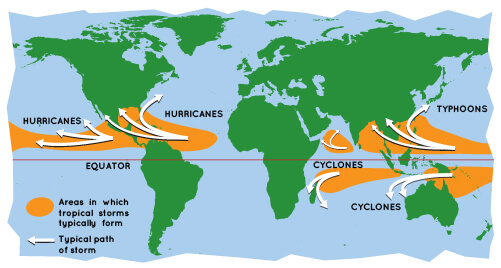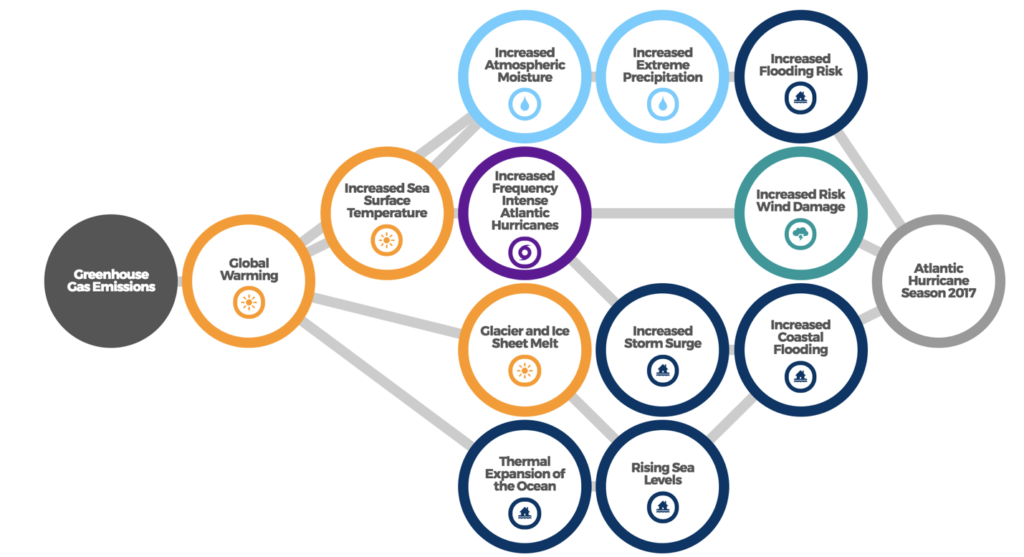Hurricanes are a part of our climate system but there has been an increased intensity of hurricanes in the north Atlantic since the 1960s. These abnormal trends are attributed largely to the increased ocean temperatures – warmer than normal Atlantic waters. This year marked the most active and 7th most destructive Atlantic hurricane season yet with 31 sub-tropical cyclones.
—

Figure 1: Source: NASA
To understand these linkages we first need to understand how a hurricane functions.
A hurricane is a large swirling storm producing winds of 74 miles per hour or higher with a low pressure centre called the eye of the hurricane. As ocean surfaces warm, so does the air above it, causing water to be carried up to high altitudes to form clouds, while leaving a low pressure zone beneath causing more air to rush in. As these systems build up, thunderstorms are formed, and if there are no strong winds to slow it down, they can become hurricanes.
Hurricanes, typhoons and cyclones are all identical just named differently depending on their areas of occurrence. Hurricanes in the Atlantic and in the central and eastern Pacific, typhoons in the northwestern Pacific, and cyclones in the Indian Ocean and South Pacific.

Figure 2 : Hurricanes start with warm ocean water found near the equator.They are formed only in the tropical regions where the ocean water temperature is at least 80 F. Source: https://spaceplace.nasa.gov/hurricanes/en/
Observations of the hurricanes in the last few years – heavier precipitation, strong storm surges and increased wind intensity – suggests strong linkages to anthropogenic climate change. As the air warms, its ability to hold water increases at the Clausius-Clapeyron rate (7% more water per degree Celsius of warming). Thus, we expect 10-15% more rain from storms in a 2°C hotter world, which would mean more occurrences of events like Hurricane Harvey (2017). It dropped over 60 inches of rain in some locations, and devastated the Houston area tallying up around US $125 billion in damages.
However, the totality of climate change’s effects on hurricane impacts is far more complex.
A closer look at how climate change is affecting hurricane activity.

Figure 3: The picture illustrates how greenhouse gas emissions are causing a disastrous hurricane season in the Atlantic and similarly in other regions.The carbon emissions trigger the chain reaction impacting the oceans and atmospheric currents leading to increased wind intensity, heavy precipitation and sea-level rise .Source: Climate analytics
Below mentioned points briefly explain the most important factors.
- Hurricanes weakening more slowly: 50 years ago, a typical storm would lose more than three quarters of its intensity in the first 24 hours after making landfall. However, decay has significantly diminished since. Scientists have suggested this may be due to the higher water content of the hurricanes, able to maintain themselves for longer after having left their source of moisture.

Figure 4: Changes in the behaviour of tropical cyclones on land since the 1960s. τ characterizes the rate of decay in hours — a bigger τ indicates a slower decay. It is evident that as the sea surface temperature rises the hurricanes take longer to strike the land. Source: https://www.nature.com/articles/d41586-020-03118-2










![The Statistics of Biodiversity Loss [2020 WWF Report]](https://u4d2z7k9.rocketcdn.me/wp-content/uploads/2020/12/lprwinkyTHB-544x306.jpg)





